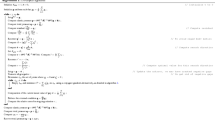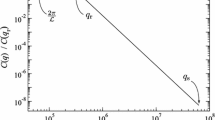Abstract
The surface micro-interaction model of Lennard-Jones (LJ) is used for adhesive contact problems (ACP). To address theoretical and numerical pitfalls of this model, a sequence of partitions of contact models is adaptively constructed to both extend and approximate the LJ model. It is formed by a combination of the LJ model with a sequence of shifted-Signorini (or, alternatively, -Linearized-LJ) models, indexed by a shift parameter field. For each model of this sequence, a weak formulation of the associated local ACP is developed. To track critical localized adhesive areas, a two-step strategy is developed: firstly, a macroscopic frictionless (as first approach) linear-elastic contact problem is solved once to detect contact separation zones. Secondly, at each shift-adaptive iteration, a micro-macro ACP is re-formulated and solved within the multiscale Arlequin framework, with significant reduction of computational costs. Comparison of our results with available analytical and numerical solutions shows the effectiveness of our global strategy.




















Similar content being viewed by others
References
Anciaux G, Ramisetti SB, Molinari JF (2012) A finite temperature bridging domain method for md-fe coupling and application to a contact problem. Comput Methods Appl Mech Eng 205:204–212
Babuška I (1973) The finite element method with lagrangian multipliers. Numer Math 20(3):179–192
Belgacem FB, Hild P, Laborde P (1998) The mortar finite element method for contact problems. Math Comput Model 28(4–8):263–271
Ben Dhia H (1988) Modelling and solution by penalty duality method of unilateral contact problems. Calcul Struct Intell Artif 2:3–18
Ben Dhia H (1995) Mathematical analysis of non-linear thin plate problems of mindlin-naghdi-reissner type existence of solutions under optimal hypotheses. C R Acad Sci 1(1):1545–1552
Ben Dhia H (1997) Plaques en grandes transformations élastiques sous contact hyperélastique. In: Actes du 3ème Colloque National de Calcul des Structures, Giens, vol 1, pp 465–470
Ben Dhia H (1998) Multiscale mechanical problems: the Arlequin method. C R Acad Sci Ser IIB Mech Phys Astron 326(12):899–904
Ben Dhia H (1999) Numerical modelling of multiscale problems: the Arlequin method. In: CD Proceedings of ECCM’99, Munchen
Ben Dhia H (2003) Aspects géométriques numériques micro-macro des interfaces. In: Modèles et Lois d’Interface pour le Contact. LMA-Marseilles
Ben Dhia H (2006) Global-local approaches: the Arlequin framework. Eur J Comput Mech 15(1–3):67–80
Ben Dhia H (2008) Further insights by theoretical investigations of the multiscale Arlequin method. Int J Multiscale Comput Eng 6(3):215–232
Ben Dhia H, Elkhodja N, Roux FX (2008) Multimodeling of multi-alterated structures in the Arlequin framework: solution with a domain-decomposition solver. Eur J Comput Mech 17(5–7):969–980
Ben Dhia H, Rateau G (2001) Mathematical analysis of the mixed Arlequin method. C R Acad Sci Ser I Math 332(7):649–654
Ben Dhia H, Rateau G (2005) The Arlequin method as a flexible engineering design tool. Int J Numer Meth Eng 62(11):1442–1462
Ben Dhia H, Torkhani M (2011) Modeling and computation of fretting wear of structures under sharp contact. Int J Numer Meth Eng 85(1):61–83
Ben Dhia H, Torkhani M, Zammali C (2005) Modèle d’interface multi-niveau pour les problèmes de contact. In: Colloque National de Calcul des Structures, Giens 2005, vol 1. Hermès Lavoisier, pp 63–68
Ben Dhia H, Zammali C (2004) Level-sets and Arlequin framework for dynamic contact problems. Rev Eur Elem 13(5–7):403–414
Ben Dhia H, Zammali C (2007) Level-sets fields, placement and velocity based formulations of contact-impact problems. Int J Numer Meth Eng 69(13):2711–2735
Ben Dhia H, Zarroug M (2002) Contact in the Arlequin framework. In: Contact mechanics. Springer, pp 403–410
Ben Dhia H, Zarroug M (2002) Hybrid frictional contact particles-in elements. Rev Eur Elem 11(2–4):417–430
Boussinesq J (1885) Application des potentiels à l’étude de l’équilibre et du mouvement des solides élastiques. Gauthier-Villars, Paris
Bradley RS (1932) Lxxix. The cohesive force between solid surfaces and the surface energy of solids. Philos Mag J Sci 13(86):853–862
Brezzi F (1974) On the existence, uniqueness and approximation of saddle-point problems arising from Lagrangian multipliers. Rev Fr Automat Inf Rech Oper Anal Numer 8(R2):129–151
Cappella B, Dietler G (1999) Force-distance curves by atomic force microscopy. Surf Sci Rep 34(1–3):15–3104
Derjaguin BV (1934) Untersuchungen über die reibung und adhäsion, iv. Colloid Polym Sci 69(2):155–164
Derjaguin BV, Muller VM, Toporov YP (1975) Effect of contact deformations on the adhesion of particles. J Colloid Interface Sci 53(2):314–326
Dimitri R, De Lorenzis L, Scott M, Wriggers P, Taylor R, Zavarise G (2014) Isogeometric large deformation frictionless contact using t-splines. Comput Methods Appl Mech Eng 269:394–414
Feng JQ (2000) Contact behavior of spherical elastic particles: a computational study of particle adhesion and deformations. Colloids Surf A 172(1):175–198
Feng JQ (2001) Adhesive contact of elastically deformable spheres: a computational study of pull-off force and contact radius. J Colloid Interface Sci 238(2):318–323
Greenwood J (1997) Adhesion of elastic spheres. Proc R Soc Lond A Math Phys Eng Sci 453(1961):1277–1297
Greenwood J, Williamson JP (1966) Contact of nominally flat surfaces. Proc R Soc Lond A Math Phys Eng Sci 295:300–319
Hoang TV, Wu L, Paquay S, Golinval JC, Arnst M, Noels L (2017) A computational stochastic multiscale methodology for mems structures involving adhesive contact. Tribol Int 110:401–425
Johnson K (1987) Contact mechanics. Cambridge University Press, Cambridge
Johnson K (1998) Mechanics of adhesion. Tribol Int 31(8):413–418
Johnson K, Kendall K, Roberts A (1971) Surface energy and the contact of elastic solids. Proc R Soc Lond A Math Phys Eng Sci 324(1558):301–313
Kloosterman G, van Damme RM, van den Boogaard AH, Huetink J (2001) A geometrical-based contact algorithm using a barrier method. Int J Numer Meth Eng 51(7):865–882
Konyukhov A, Schweizerhof K (2008) On the solvability of closest point projection procedures in contact analysis: analysis and solution strategy for surfaces of arbitrary geometry. Comput Methods Appl Mech Eng 197(33):3045–3056
Laursen TA (2003) Computational contact and impact mechanics: fundamentals of modelling interfacial phenomena in nonlinear finite element analysis. Springer, Berlin
Maday Y, Mavriplis C, Patera A (1989) Nonconforming mortar element methods: application to spectral discretizations. In: Chan T, Glowinski R, Periaux J, Widlund OB (eds) Domain decomposition methods. SIAM, Philadelphia, pp 392–418
Maugis D (1992) Adhesion of spheres: the jkr-dmt transition using a dugdale model. J Colloid Interface Sci 150(1):243–269
Medina S, Dini D (2014) A numerical model for the deterministic analysis of adhesive rough contacts down to the nano-scale. Int J Solids Struct 51(14):2620–2632
Muller V, Yushchenko V, Derjaguin B (1980) On the influence of molecular forces on the deformation of an elastic sphere and its sticking to a rigid plane. J Colloid Interface Sci 77(1):91–101
Puso MA, Laursen TA (2004) A mortar segment-to-segment contact method for large deformation solid mechanics. Comput Methods Appl Mech Eng 193(6):601–629
Qian D, Wagner GJ, Liu WK, Yu MF, Ruoff RS (2002) Mechanics of carbon nanotubes. Appl Mech Rev 55(6):495–533
Sauer RA (2011) Enriched contact finite elements for stable peeling computations. Int J Numer Methods Eng 87(6):593–616
Sauer RA (2016) A survey of computational models for adhesion. J Adhes 92(2):81–120
Sauer RA, Li S (2007) An atomic interaction-based continuum model for adhesive contact mechanics. Finite Elem Anal Des 43(5):384–396
Sauer RA, Li S (2007) An atomic interaction-based continuum model for computational multiscale contact mechanics. PAMM 7(1):4080,029–4080,030
Tabor D (1977) Surface forces and surface interactions. J Colloid Interface Sci 58(1):2–13
Tur M, Giner E, Fuenmayor F, Wriggers P (2012) 2d contact smooth formulation based on the mortar method. Comput Methods Appl Mech Eng 247:1–14
Wellmann C, Wriggers P (2011) A concurrent multiscale approach to non-cohesive granular materials. In: Recent developments and innovative applications in computational mechanics. Springer, pp 257–264
Wriggers P (1995) Finite element algorithms for contact problems. Arch Comput Methods Eng 2(4):1–49
Wriggers P (2006) Computational contact mechanics, 2nd edn. Springer, Berlin
Wriggers P, Rust W, Reddy B (2016) A virtual element method for contact. Comput Mech 58(6):1039–1050
Wu JJ (2006) Nanoadhesion between a rigid circular disc and an infinite elastic surface. Int J Solids Struct 43(6):1624–1637
Zavarise G, Wriggers P, Schrefler B (1998) A method for solving contact problems. Int J Numer Methods Eng 42(3):473–498
Author information
Authors and Affiliations
Corresponding author
Additional information
Publisher's Note
Springer Nature remains neutral with regard to jurisdictional claims in published maps and institutional affiliations.
Rights and permissions
About this article
Cite this article
Ben Dhia, H., Du, S. A model-adaptivity method for the solution of Lennard-Jones based adhesive contact problems. Comput Mech 62, 1543–1562 (2018). https://doi.org/10.1007/s00466-018-1578-5
Received:
Accepted:
Published:
Issue Date:
DOI: https://doi.org/10.1007/s00466-018-1578-5




